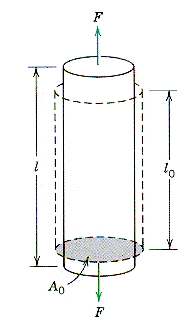|
Mechanical
Properties
How
a material responds to a load is best expressed in terms of the size independent
quantities stress and strain. the diagram illustrates a cylindrical sample
of initial area A0 that is being loaded in tension by a force,
F. As a result of the application of this force the sample changes from
an initial unloaded length, L, to a final loaded length, L0.
In terms of these quantities, the stress is given by: s
= F/A0,
and the associated strain by: e
= (L0 - L)/L0 = DL/L0.
These quantities are known as the Engineering Stress and the Engineering
Strain.
In
the elastic response range for the material being tested stress and strain
are related through a material property known as an "Elastic Constant."
For the tensile situation illustrated the elastic constant is known as
Young's modulus and the elastic relationship is "Hooke's law." This is
written: s
= E e.
This linear relationship does not hold for all types of material. For example
a rubber remains elastic over a very large range of strains but the slope
of the stress-strain plot depends on the value of the strain. Materials
that behave in this way are non-linear elastic materials and their elastic
modulus E* = (ds/de)
is strain dependent. The definition of E* used is for the "Tangent modulus"
for the non-linear material.
|
|
|
|
|
|
|
|
|
|
